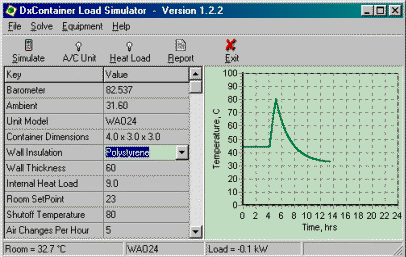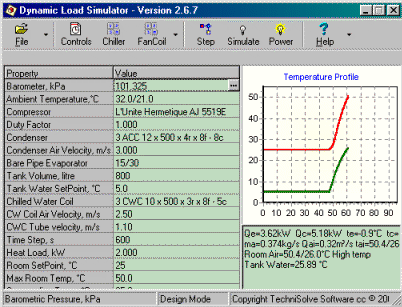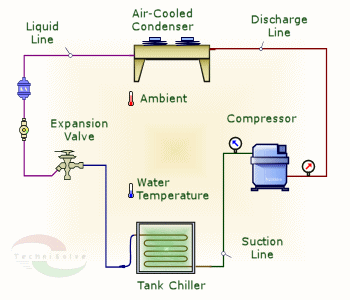 This program was written by TechniSolve Software
to simulate the temperature profile in a remote telephone exchange after a
power failure using a DX split unit.
This program was written by TechniSolve Software
to simulate the temperature profile in a remote telephone exchange after a
power failure using a DX split unit.Last updated by BJ Wernick PrEng, BScEng
Thursday, August 16, 2007
In South Africa, there are many remote telephone exchanges. These are typically small containers with abnormally high sensible heat loads.
Due to the remote locations, it is necessary to ensure that the airconditioning has certain safeties that would allow it to recover from faults. We were concerned here with the thermal response after a power failure.
 This program was written by TechniSolve Software
to simulate the temperature profile in a remote telephone exchange after a
power failure using a DX split unit.
This program was written by TechniSolve Software
to simulate the temperature profile in a remote telephone exchange after a
power failure using a DX split unit.
We show the benefit of having a chilled water system with a thermal store. The advantage with this option is that it provides a number of hours capacity before the room temperature reaches a critical temperature forcing complete shutdown.
Internally, the programs do a complete vapor compression cycle simulation, taking into account the room moist air state and the psychrometrics of the ambient air. In the tank chiller model, we have developed a low cost bare pipe evaporator using a non-pressurized PVC water tank.
 The above cooling systems have been integrated into the new submerged
container. For security reasons, the container is completely submerged
below the ground. The only visible parts are the mast and the access
hatch. The cooling package circulates air within the container and rejects
heat into the mast cavity.
The above cooling systems have been integrated into the new submerged
container. For security reasons, the container is completely submerged
below the ground. The only visible parts are the mast and the access
hatch. The cooling package circulates air within the container and rejects
heat into the mast cavity.
The power of this type of simulation is that the results are repeatable, allowing for easy optimization of component selections without the cost of equipment prototypes.
This particular calculation combines the heat load with the equipment performance to give the dynamic time varying performance of the complete system.
From the graphic, you can immediately see the time that the room takes to reach an unacceptably high temperature. In addition, you are able to optimize the size of the storage tank and the cooling system components simply by changing the parameters and re-calculating. Try doing that with a catalog table!
We have now integrated the tank chiller into RefSim. Clearly, this is no big step. All we had to do was write a bare pipe evaporator into our heat exchanger library and out pops a complete package.

Soon, all of the components will be interchangeable, allowing you to design air-cooler, water-cooler or evap-condenser cooler. Need a water cooled chiller? No problem, just use a shell and tube condenser with a shell and tube evaporator. How about an evap-condenser cooler air-conditioner? Select an evaporator coil with an evap-condenser and away you go.
Visit TechniSolve Software for more information and software downloads